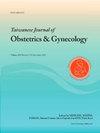Placental mesenchymal dysplasia: A cause of intrauterine growth restriction and intrauterine death
IF 2.2
4区 医学
Q2 OBSTETRICS & GYNECOLOGY
引用次数: 0
Abstract
Objective
This study emphasizes the importance of recognizing and accurately diagnosing PMD and describes the clinical, gross, and histopathological findings of PMD in 18 cases. Placental mesenchymal dysplasia (PMD) was first recognized by Takayama et al. as a distinct pathologic entity of the placenta. The actual incidence and clinical outcomes of PMD haven’t been clarified yet.
Materials and methods
Eighteen patients diagnosed with PMD among 3760 placentas were reevaluated according to morphological diagnostic criteria and the immunohistochemical expression profile of p57.
Results
In all cases of PMD, abnormally enlarged stem villi, some of which had cisterns, hypercellular stroma, and thick-walled vessels, were present. Additionally, central thick-walled blood vessels with constricted lumens and scattered peripheral tiny capillaries were observed. In 14 cases of PMD, loss of p57 expression in stromal cells of dysplastic stem villi and chorangiomatoid changes was observed.
Conclusion
PMD is a rare and clinically significant lesion with high rates of IUFD and neonatal death. To diagnose PMD cases accurately and manage potential complications correctly, pregnancies with suspected PMD should be followed up in tertiary centers with resources for perinatal care and perinatal pathology testing.
胎盘间充质发育不良:宫内生长受限和宫内死亡的原因
目的总结18例经前症候群的临床、大体和组织病理学表现,强调识别和准确诊断经前症候群的重要性。胎盘间充质发育不良(PMD)首先被Takayama等人认为是胎盘的一种独特的病理实体。PMD的实际发病率和临床结果尚未明确。材料与方法根据形态学诊断标准和p57的免疫组织化学表达谱对3760例胎盘中18例诊断为PMD的患者进行重新评估。结果所有PMD患者均有异常增大的干绒毛,部分干绒毛有贮池、高细胞间质和厚壁血管。此外,可见中央厚壁血管,管腔收缩,周围细小毛细血管分散。在14例PMD中,观察到p57在发育不良的干绒毛间质细胞中的表达缺失和脉管瘤样改变。结论pmd是一种罕见且具有临床意义的病变,具有较高的IUFD和新生儿死亡率。为了准确诊断PMD病例并正确处理潜在的并发症,应在有围产期护理和围产期病理检查资源的三级中心对疑似PMD的孕妇进行随访。
本文章由计算机程序翻译,如有差异,请以英文原文为准。
求助全文
约1分钟内获得全文
求助全文
来源期刊

Taiwanese Journal of Obstetrics & Gynecology
OBSTETRICS & GYNECOLOGY-
CiteScore
3.60
自引率
23.80%
发文量
207
审稿时长
4-8 weeks
期刊介绍:
Taiwanese Journal of Obstetrics and Gynecology is a peer-reviewed journal and open access publishing editorials, reviews, original articles, short communications, case reports, research letters, correspondence and letters to the editor in the field of obstetrics and gynecology.
The aims of the journal are to:
1.Publish cutting-edge, innovative and topical research that addresses screening, diagnosis, management and care in women''s health
2.Deliver evidence-based information
3.Promote the sharing of clinical experience
4.Address women-related health promotion
The journal provides comprehensive coverage of topics in obstetrics & gynecology and women''s health including maternal-fetal medicine, reproductive endocrinology/infertility, and gynecologic oncology. Taiwan Association of Obstetrics and Gynecology.
 求助内容:
求助内容: 应助结果提醒方式:
应助结果提醒方式:


